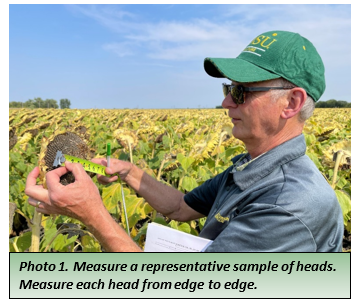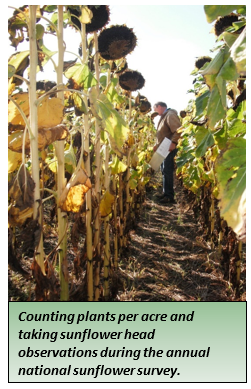Estimating Sunflower Yield
This page was adapted from the article, "Estimating Sunflower Yield," which appeared in Crop & Pest Report on September 23, 2021. Edited on March 22, 2023.
Yield for sunflower can be calculated by mutliplying a number of factors, including:
- the number of plants per acre
- the head diameter
- the seed size
- the number of filled seeds per head
- observing how much of the center of the head is filled
- estimating the damage done by birds
The yield is calculated by multiplying 2,450 by the “multipliers” from the tables in this article.
First, estimate the plant population from a number of locations within a field, away from the headlands. The number of plants per 20 feet of row can easily be established. With solid-seeded sunflower, getting a good population estimate is more difficult.
Table 1. Sunflower population (in rows or solid-seeded) and multiplier to be used in the formula.
|
Plants per acre |
Plants per 20 feet of 14" row | Plants per 20 feet of 28" row |
Multiplier |
| 14,000 | 7.5 | 15 | 0.70 |
| 15,000 | 8 | 16 | 0.75 |
| 16,000 | 8.5 | 17 | 0.80 |
| 17,000 | 9 | 18 | 0.85 |
| 18,000 | 9.5 | 19 | 0.80 |
| 19,000 | 10 | 20 | 0.95 |
| 20,000 | 10.5 | 21.5 | 1.00 |
| 21,000 | 11.3 | 22.5 | 1.05 |
| 22,000 | 11.8 | 23.5 | 1.10 |
| 23,000 | 12.3 | 24.5 | 1.15 |
| 24,000 | 13 | 26 | 1.20 |
For plant populations between the numbers in Table 1, the value of the multiplier can be estimated.
The next measurement is the sunflower head diameter. Measure a number of heads in the field (photo 1), and take the average. it is important to measure a number of heads in the field. Plants with more space tend to have larger heads so it is important to take a representative field sample. Average the head diameter by selecting 25 or more sunflower heads randomly. Try to avoid abnormally large or small heads.

Table 2. Average sunflower head diameter in inches and multiplier to be used in formula.
|
Head diameter (inches) |
Multiplier |
| 4.5 | 0.37 |
| 5.0 | 0.46 |
| 5.5 | 0.55 |
| 6.0 | 0.64 |
| 6.5 | 0.73 |
| 7.0 | 0.82 |
| 7.5 | 0.91 |
| 8.0 | 1.00 |
| 8.5 | 1.09 |
| 9.0 | 1.18 |
| 9.5 | 1.27 |
| 10.0 | 1.36 |
Percentage Good Seed Set: Cut a slice out of the sunflower head and hand-remove the seeds, then estimate the percentage of filled seeds. For instance, when observing 100 seeds of which 15 seeds are either not filled or severely damaged due to insects, the multiplier will be 0.85 (85 % filled seeds).
Center Seed Set: If there is no seed set in the center one inch of the head, multiply by 0.975; if no seeds are set in the center two inches of the head, multiply by 0.95; if there is a hole in the center of the head, multiply by 0.9. Take the average seed set from a number of plants.
The next multiplier is related to the seed size. Cut a small wedge out of a few heads, hand-thresh the seed and place the seeds in small container. Do not use the center of the head as those seeds are usually very small and that yield has been accounted for in the Seed Set multiplier. Take a representative seed sample from bucket and determine seed size for the multiplier (Figure 1).

Table 3. Seed Size and multiplier to use.
|
Seed Size |
Width in mm |
Length in mm |
Multiplier |
| Light | 4.2 | 7.3 | 0.8 |
| Medium Light | 5.2 | 7.8 | 0.9 |
| Medium | 5.8 | 8.9 | 1.0 |
| Medium Heavy | 5.8 | 9.9 | 1.1 |
| Heavy | 5.8 | 11.0 | 1.2 |
Lastly observe if there is bird damage to the heads. If there is 2% damage, there is no damage for 98% of the head and the correction factor will be 0.98.
Yield Calculation
Yield is calculated by multiplying 2,450 by the multipliers from the tables. For example in a sunflower field with a stand of 20,000 plants per acre, average head size of 6.5 inches, a medium seed size with good seed count of 95%, and average no seed in the center of the head of one inch, and 2% bird damage you would do the following.

Multipliers used: 2,450 x plant population x head size x seed size x good seed count x center seed set x no bird damage = lbs/acre.
Yield calculations for this example field would therefore be: 2,450 x 1.0 x 0.73 x 1.0 x 0.95 x 0.975 x 0.98 = 1623 lbs/acre. The yield estimate for this example is 1623 lbs per acre. The actual yield may be lower if not all heads can be harvested and/or additional bird damage will occur.
Reference:
National Sunflower Association article How to Estimate Yield
Hans Kandel
Extension Agronomist Broadleaf Crops
